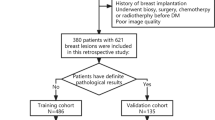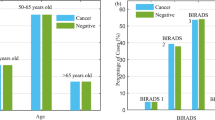Abstract
The purpose of this study was to develop and assess a new quantitative four-view mammographic image feature based fusion model to predict the near-term breast cancer risk of the individual women after a negative screening mammography examination of interest. The dataset included fully-anonymized mammograms acquired on 870 women with two sequential full-field digital mammography examinations. For each woman, the first “prior” examination in the series was interpreted as negative (not recalled) during the original image reading. In the second “current” examination, 430 women were diagnosed with pathology verified cancers and 440 remained negative (“cancer-free”). For each of four bilateral craniocaudal and mediolateral oblique view images of left and right breasts, we computed and analyzed eight groups of global mammographic texture and tissue density image features. A risk prediction model based on three artificial neural networks was developed to fuse image features computed from two bilateral views of four images. The risk model performance was tested using a ten-fold cross-validation method and a number of performance evaluation indices including the area under the receiver operating characteristic curve (AUC) and odds ratio (OR). The highest AUC = 0.725 ± 0.026 was obtained when the model was trained by gray-level run length statistics texture features computed on dense breast regions, which was significantly higher than the AUC values achieved using the model trained by only two bilateral one-view images (p < 0.02). The adjustable OR values monotonically increased from 1.0 to 11.8 as model-generated risk score increased. The regression analysis of OR values also showed a significant increase trend in slope (p < 0.01). As a result, this preliminary study demonstrated that a new four-view mammographic image feature based risk model could provide useful and supplementary image information to help predict the near-term breast cancer risk.






Similar content being viewed by others
References
Al-Kadi, O. S., and D. Watson. Texture analysis of aggressive and nonaggressive lung tumor CE CT images. IEEE Trans. Biomed. Eng. 55:1822–1830, 2008.
Amir, E., O. C. Freedman, B. Seruga, and D. G. Evans. Assessing women at high risk of breast cancer: a review of risk assessment models. J. Natl Cancer Inst. 102:680–691, 2010.
Berg, W. A., C. Campassi, P. Langenberg, and M. J. Sexton. Breast Imaging Reporting and Data System: inter- and intraobserver variability in feature analysis and final assessment. AJR Am. J. Roentgenol. 174:1769–1777, 2000.
Berlin, L., and F. M. Hall. More mammography muddle: emotions, politics, science, costs, and polarization. Radiology 255:311–316, 2010.
Bertrand, K. A., R. M. Tamimi, C. G. Scott, M. R. Jensen, V. S. Pankratz, D. Visscher, A. Norman, F. Couch, J. Shepherd, B. Fan, Y. Y. Chen, L. Ma, A. H. Beck, S. R. Cummings, K. Kerlikowske, and C. M. Vachon. Mammographic density and risk of breast cancer by age and tumor characteristics. Breast Cancer Res. 15:R104, 2013; ((Epub ahead of print)).
Boughey, J. C., L. C. Hartmann, S. S. Anderson, A. C. Degnim, R. A. Vierkant, C. A. Reynolds, M. H. Frost, and V. S. Pankratz. Evaluation of the Tyrer-Cuzick (International Breast Cancer Intervention Study) model for breast cancer risk prediction in women with atypical hyperplasia. J. Clin. Oncol. 28:3591–3596, 2010.
Boyd, N. F., L. J. Martin, M. J. Yaffe, and S. Minkin. Mammographic density and breast cancer risk: current understanding and future prospects. Breast Cancer Res. 13:223, 2011.
Brawley, O. W. Risk-based mammography screening: an effort to maximize the benefits and minimize the harms. Ann. Intern. Med. 156:662–663, 2012.
Byng, J. W., N. F. Boyd, E. Fishell, R. A. Jong, and M. J. Yaffe. The quantitative analysis of mammographic densities. Phys. Med. Biol. 39:1629–1638, 1994.
Chang, Y.-H., X.-H. Wang, L. A. Hardesty, T. S. Chang, W. R. Poller, W. F. Good, and D. Gur. Computerized assessment of tissue composition on digitized mammograms. Acad. Radiol. 9:899–905, 2002.
Chen, J., S. Shan, C. He, G. Zhao, M. Pietikainen, X. Chen, and W. Gao. WLD: a robust local image descriptor. IEEE Trans. Pattern Anal. Mach. Intell. 32:1705–1720, 2010.
Clausi, D. A. An analysis of co-occurrence texture statistics as a function of grey level quantization. Can. J. Remote Sens. 28:45–62, 2002.
Daugman, J. G. Complete discrete 2-D Gabor transforms by neural networks for image analysis and compression. IEEE Trans. Acoust. Speech Signal Process. 36:1169–1179, 1988.
DeLong, E. R., D. M. DeLong, and D. L. Clarke-Pearson. Comparing the areas under two or more correlated receiver operating characteristic curves: a nonparametric approach. Biometrics 11:837–845, 1988.
Gail, M. H. Personalized estimates of breast cancer risk in clinical practice and public health. Stat. Med. 30:1090–1104, 2011.
Gail, M. H., and P. L. Mai. Comparing breast cancer risk assessment models. J. Natl Cancer Inst. 102:665–668, 2010.
Gierach, G. L., H. Li, J. T. Loud, M. H. Greene, C. K. Chow, L. Lan, S. A. Prindiville, J. Eng-Wong, P. W. Soballe, C. Giambartolomei, P. L. Mai, C. E. Galbo, K. Nichols, K. A. Calzone, O. I. Olopade, M. H. Gail, and M. L. Giger. Relationships between computer-extracted mammographic texture pattern features and BRCA1/2 mutation status: a cross-sectional study. Breast Cancer Res. 16:424, 2014.
Häberle, L., F. Wagner, P. Fasching, S. Jud, K. Heusinger, C. Loehberg, A. Hein, C. Bayer, C. Hack, M. Lux, K. Binder, M. Elter, C. Münzenmayer, R. Schulz-Wendtland, M. Meier-Meitinger, B. Adamietz, M. Uder, M. Beckmann, and T. Wittenberg. Characterizing mammographic images by using generic texture features. Breast Cancer Res. 14:1–12, 2012.
Haghighat, M., S. Zonouz, and M. Abdel-Mottaleb. Identification using encrypted biometrics. In: Computer Analysis of Images and Patterns, edited by R. Wilson, E. Hancock, A. Bors, and W. Smith. Berlin: Springer, 2013, pp. 440–448.
Haralick, R. M., K. Shanmugam, and I. Dinstein. Texture features for image classification. IEEE Trans. Syst. Man Cybernet. 3:610–621, 1973.
Heine, J. J., C. G. Scott, T. A. Sellers, K. R. Brandt, D. J. Serie, F. F. Wu, M. J. Morton, B. A. Schueler, F. J. Couch, J. E. Olson, V. S. Pankratz, and C. M. Vachon. A novel automated mammographic density measure and breast cancer risk. J. Natl. Cancer Inst. 104:1028–1037, 2012.
Jørgensen, K. J. Is the tide turning against breast screening? Breast Cancer Res. 14:107–107, 2012.
Li, H., M. L. Giger, O. I. Olopade, and M. R. Chinander. Power spectral analysis of mammographic parenchymal patterns for breast cancer risk assessment. J. Digit. Imaging 21:145–152, 2008.
Li, J., L. Szekely, L. Eriksson, B. Heddson, A. Sundbom, K. Czene, P. Hall, and K. Humphreys. High-throughput mammographic-density measurement: a tool for risk prediction of breast cancer. Breast Cancer Res. 14:R114, 2012.
Manduca, A., M. J. Carston, J. J. Heine, C. G. Scott, V. S. Pankratz, K. R. Brandt, T. A. Sellers, C. M. Vachon, and J. R. Cerhan. Texture features from mammographic images and risk of breast cancer. Cancer Epidemiol. Biomarkers Prev. 18:837–845, 2009.
Marcelja, S. Mathematical description of the responses of simple cortical cells. J. Opt. Soc. Am. 70:1297–1300, 1980.
Mudigonda, N. R., R. M. Rangayyan, and J. E. Desautels. Gradient and texture analysis for the classification of mammographic masses. IEEE Trans. Med. Imaging 19:1032–1043, 2000.
Nielsen, M., G. Karemore, M. Loog, J. Raundahl, N. Karssemeijer, J. D. Otten, M. A. Karsdal, C. M. Vachon, and C. Christiansen. A novel and automatic mammographic texture resemblance marker is an independent risk factor for breast cancer. Cancer Epidemiol. 35:381–387, 2011.
Pankratz, V. S., A. C. Degnim, R. D. Frank, M. H. Frost, D. W. Visscher, R. A. Vierkant, T. J. Hieken, K. Ghosh, Y. Tarabishy, C. M. Vachon, D. C. Radisky, and L. C. Hartmann. Model for individualized prediction of breast cancer risk after a benign breast biopsy. J. Clin. Oncol. 33:923–929, 2015.
Passaperuma, K., E. Warner, K. A. Hill, A. Gunasekara, and M. J. Yaffe. Is mammographic breast density a breast cancer risk factor in women with BRCA mutations? J. Clin. Oncol. 28:3779–3783, 2010.
Rumelhart, D. E., G. E. Hinton, and R. J. Williams. Learning representations by back-propagating errors. Nature 323:533–536, 1986.
Schousboe, J. T., K. Kerlikowske, A. Loh, and S. R. Cummings. Personalizing mammography by breast density and other risk factors for breast cancer: analysis of health benefits and cost-effectiveness. Ann. Intern. Med. 155:10–20, 2011.
Soh, L. K., and C. Tsatsoulis. Texture analysis of SAR sea ice imagery using gray level co-occurrence matrices. IEEE Trans. Geosci. Remote Sens. 37:780–795, 1999.
Steyerberg, E. W., A. J. Vickers, N. R. Cook, T. Gerds, M. Gonen, N. Obuchowski, M. J. Pencina, and M. W. Kattan. Assessing the performance of prediction models: a framework for traditional and novel measures. Epidemiology 21:128–138, 2010.
Tan, M., J. Pu, and B. Zheng. Reduction of false-positive recalls using a computerized mammographic image feature analysis scheme. Phys. Med. Biol. 59:4357–4373, 2014.
Tan, M., B. Zheng, P. Ramalingam, and D. Gur. Prediction of near-term breast cancer risk based on bilateral mammographic feature asymmetry. Acad. Radiol. 20:1542–1550, 2013.
Tang, X. Texture information in run-length matrices. IEEE Trans. Image Proc. 7:1602–1609, 1998.
Varela, C., S. Timp, and N. Karssemeijer. Use of border information in the classification of mammographic masses. Phys. Med. Biol. 51:425–441, 2006.
Ververidis, D., and C. Kotropoulos. Fast and accurate sequential floating forward feature selection with the Bayes classifier applied to speech emotion recognition. Signal Process. 88:2956–2970, 2008.
Wang, X., D. Lederman, J. Tan, X. H. Wang, and B. Zheng. Computerized prediction of risk for developing breast cancer based on bilateral mammographic breast tissue asymmetry. Med. Eng. Phys. 33:934–942, 2011.
Wei C.-H., Y. Li and C.-T. Li. Effective Extraction of Gabor Features for Adaptive Mammogram Retrieval. In: IEEE International Conference on Multimedia and Expo, Beijing, 2007, pp. 1503–1506.
Wei, J., H. P. Chan, Y. T. Wu, et al. Association of computerized mammographic parenchymal pattern measure with breast cancer risk: a pilot case–control study. Radiology 260:42–49, 2011.
Wei, X. Gray Level Run Length Matrix Toolbox v1.0. Beijing Aeronautical Technology Research Center, http://www.mathworks.com/matlabcentral/fileexchange/17482-gray-level-run-length-matrix-toolbox. Last accessed: 16 February 2015, 2007.
Zheng, B., J. H. Sumkin, M. L. Zuley, D. Lederman, X. Wang, and D. Gur. Computer-aided detection of breast masses depicted on full-field digital mammograms: a performance assessment. Br. J. Radiol. 85:e153–e161, 2012.
Zheng, B., J. H. Sumkin, M. L. Zuley, X. Wang, A. H. Klym, and D. Gur. Bilateral mammographic density asymmetry and breast cancer risk: a preliminary assessment. Eur. J. Radiol. 81:3222–3228, 2012.
Acknowledgments
This study is supported in part by Grant R01 CA160205 from the National Cancer Institute, National Institutes of Health. The authors also acknowledge the support received from the Peggy and Charles Stephenson Cancer Center, University of Oklahoma.
Conflict of interest
There are no conflicts of interest in relation to this work.
Author information
Authors and Affiliations
Corresponding author
Additional information
Associate Editor Agata A. Exner oversaw the review of this article.
Rights and permissions
About this article
Cite this article
Tan, M., Pu, J., Cheng, S. et al. Assessment of a Four-View Mammographic Image Feature Based Fusion Model to Predict Near-Term Breast Cancer Risk. Ann Biomed Eng 43, 2416–2428 (2015). https://doi.org/10.1007/s10439-015-1316-5
Received:
Accepted:
Published:
Issue Date:
DOI: https://doi.org/10.1007/s10439-015-1316-5




